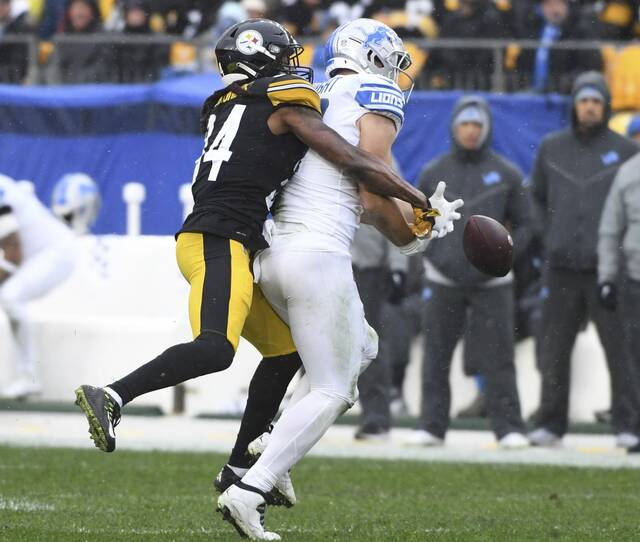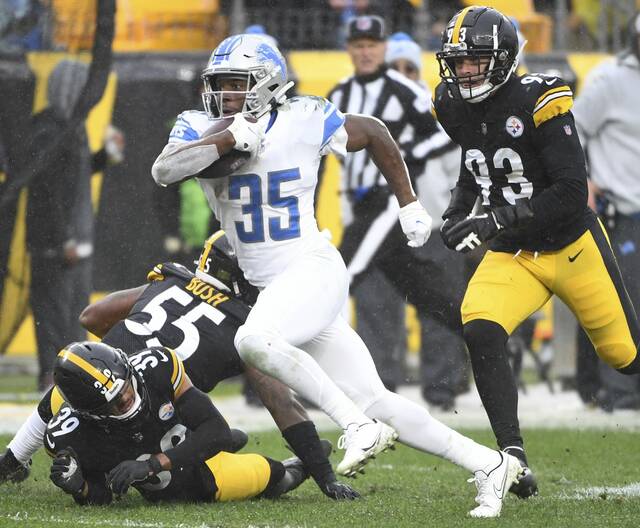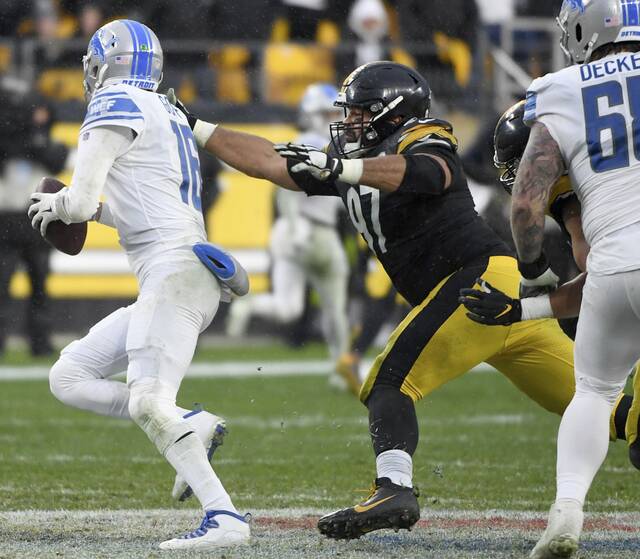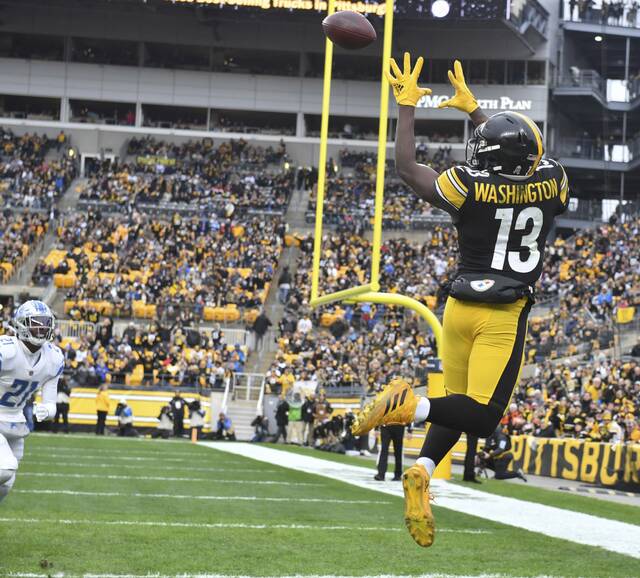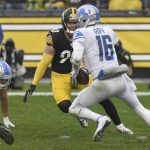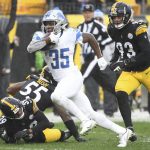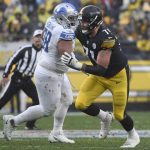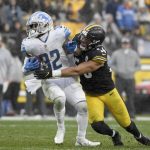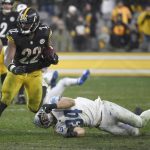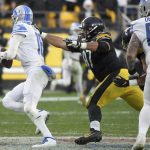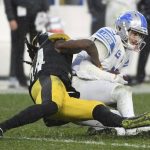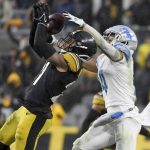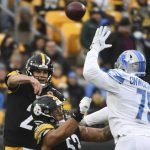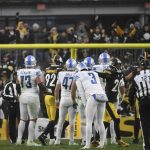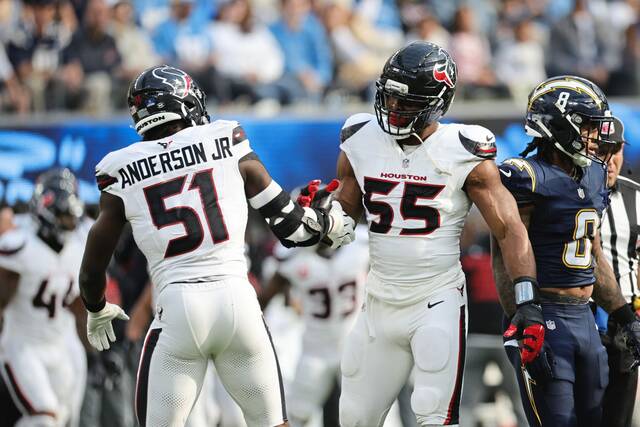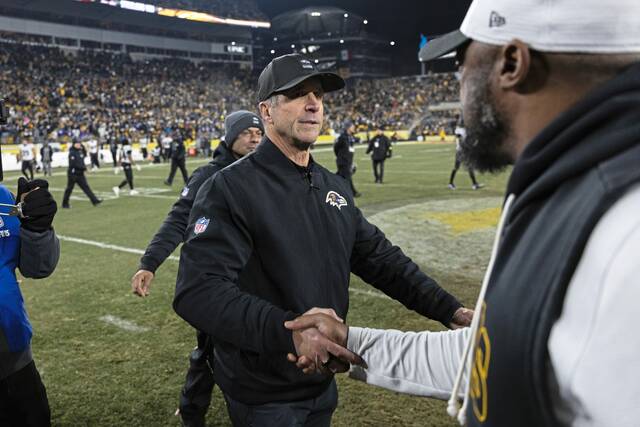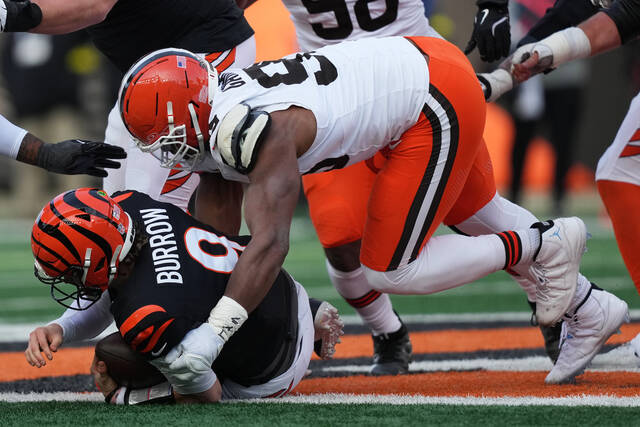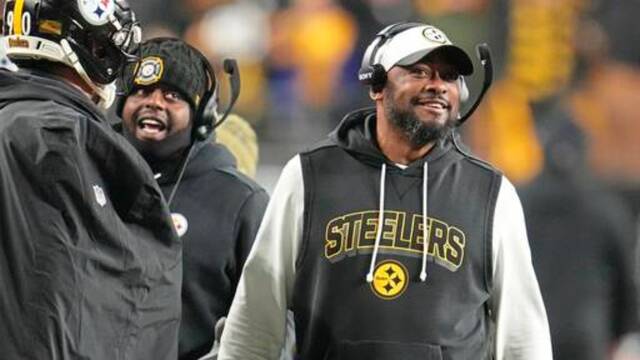NFL football analyst Matt Williamson will break down each of the Steelers games this season in the Trib’s Steelers Film Study. Here’s what he saw in the Steelers’ Week 10 tie with the Lions.
The winless Lions came to Heinz Field on Sunday to take on a Mason Rudolph-led Pittsburgh team that had won its last four games.
Meanwhile, Detroit had been outscored by 70 points over its past three games and, on average, the usual Lions game in 2021 resulted in a 13.7-point loss. Well, the Lions’ winless streak remained intact, and the Steelers still haven’t lost a game since Week 4. That’s one way of looking at a 16-16 tie.
This was a game that was greatly influenced by weather, poor field conditions and injuries. But it was also just a case of awful execution, and the Steelers made too many mistakes. This was about as tough of an NFL game to watch as you will see.
This was the third game played at Heinz in the last seven days. The weather was terrible from the start and only got worse as the game went on. The field was in bad shape, much more so outside the numbers. Such conditions can be a great equalizer and generally, greatly favors the less talented team. Could that have been in play in this game? Sure, and it certainly was a factor and equalizer, but that by no means excuses what we saw from the Steelers.
Stats tell a story
Here are the key numbers to know from this tie game:
• First off, the Steelers were unable to win a game in which the opposing quarterback threw for only 114 yards on 25 attempts. Jared Goff had 11 passing yards at halftime and 35 after three quarters of play.
The Lions ended up with 229 rushing yards, 130 of those by D’Andre Swift, and averaged 5.9 yards per carry. Through the first three quarters of play, Detroit averaged 8.4 yards per rush. That happened even though Goff was clearly struggling with a back injury from basically the start of the game and that the Lions have quite possibly the NFL’s worst group of wide receivers.
The Lions might have the NFL’s least threatening passing attack. The Lions best receiver, TJ Hockenson, didn’t catch one pass in this game. And still, the Lions gouged Pittsburgh on the ground.
• Coming into this game, the Lions were being out-rushed 134.5 to 93.1 on average through eight games. Overall, the Steelers averaged 4.8 yards per play compared to 4.5 for Detroit.
• Pittsburgh had about three and a half more minutes of possession in a game that had 149 total plays from scrimmage.
• Rudolph wasn’t sacked on his 50 pass attempts, but Goff went down four times while attempting half as many throws.
• There were 35 total snaps on third downs and 16 punts.
• The Lions were the more heavily penalized team, but they also won the turnover battle 3-0, which could be the most crucial stat of this entire game.
Special, and not so special teams
Special teams were huge in this game and, entering this contest, this phase was far and away the thing Detroit had done best in its winless season. The Lions won that phase and Pittsburgh had too many negative plays on teams.
Steelers kicker Chris Boswell made his three field goals and lone extra point attempt. He’s a star.
Lions kicker Ryan Santoso, who was brought in because of injury, missed an overtime field goal try in ugly fashion and missed an extra point earlier in the game. Obviously, that one point cost the Lions.
The Lions’ Kalif Raymond had a 48-yard punt return while Pittsburgh didn’t get much out of Ray Ray McCloud as a punt or kick returner.
And then there was the special teams play that never happened: the possible Boswell game-winner as time expires in overtime. But fans were robbed of that situation after the Steelers’ Pat Freiermuth fumbled in the final seconds of OT.
Rudolph’s season debut
Now, let’s get to Pittsburgh’s offense and Rudolph. He threw the ball poorly. The weather obviously was a huge obstacle to overcome. Most quarterbacks would struggle without question, but Rudolph simply doesn’t throw the football well enough for this league.
He is not a power thrower, and his ball too frequently flutters or hangs up too long. That won’t work in this area of the country in November and beyond. He locked onto his first read too often and missed far too many easy throws, usually high.
His average depth of target was just 6.8 yards downfield and only 40% of Rudolph’s throws were past the first down marker. And he was rarely pressured.
Rudolph made a couple big runs against Detroit, but overall, he is a moderate athlete for today’s NFL at this position and isn’t much of a creator when plays don’t go to script. The first drive aside, which was clean and efficient, Rudolph played like an average to below average backup against one of the NFL’s worst defenses.
Rudolph was put in a tough spot, but more was needed from him and far too many plays were left on the field. This was Rudolph’s 10th career start.
Tough day for pass catchers
Diontae Johnson, McCloud and Freiermuth were targeted a combined 34 times. Running back Najee Harris had the ball thrown his way six times, as well. Pittsburgh was most successful when targeting Lions DB Jerry Jacobs.
Collectively, the pass catchers could have done more though and made more plays for their quarterback. Freiermuth had a tough day overall. Wide receiver James Washington played 87% of the snaps and finished the afternoon with two catches for 15 yards. And, of course, fumbles by Johnson and Freiermuth in overtime are simply inexcusable.
Harris in control again
Harris was the locomotive pulling the Steelers’ offense once again. Harris showed he can be a “mudder” and handle poor weather, something he didn’t have to deal with in college. The big guys up front did a nice job, but Harris got a lot of yardage on his own in impressive fashion with a blend of power, agility, balance and great competitiveness. Harris also did a nice job in pass protection and has been rock solid in that capacity, which is rare for rookie running backs.
Linemen up to challenge
Despite losing guard Kevin Dotson, who played well in his 32 snaps, and then a later injury to fellow guard Trai Turner, the Steelers offensive line played a respectable game. It wasn’t the ideal situation to have reserve B.J. Finney inactive, but JC Hassenauer and Joe Haeg filled in quite well.
Give Haeg credit, there have been several instances where he is thrown into the mix mid-game at guard or tackle, and he has held his own. That has a lot of value. Haeg played 36 snaps and Hassenauer was on the field for 54 plays. As mentioned, Rudolph wasn’t sacked and was rarely touched. But it must be mentioned that center Kendrick Green was flat-out terrible snapping the ball pretty much the entire game. Give Green credit though, as his pass protection was outstanding.
Offensive thoughts
Still, why didn’t the Steelers lean on Harris, or more specifically the running game as a whole even if it meant using Kalen Ballage or Benny Snell, even more as they have in recent weeks? This is especially true considering the weather, field conditions, quarterback, lack of wide receiver Chase Claypool (injury) and overall state of the offense on Sunday.
Harris did touch the ball 30 times, but in hindsight, should Rudolph really throw 50 passes? Pittsburgh averaged 4.8 yards per throw…and 4.7 yards per rush. The way the Lions schemed their defense with a lot of single high coverage and eight-man boxes showed they had no fear of Rudolph. The Steelers should have taken a page from their opponent and run it like crazy anyway. Pittsburgh was only trailing in this game for 22% of the total snaps. The Steelers weren’t forced to throw.
It was surprising that tackle Zach Banner wasn’t mixed in Sunday as a sixth offensive lineman to utilize more heavy personnel packages. It was also surprising that Rudolph didn’t operate under center more than he did. That would have aided the run attack, as well as play-action game.
And lastly from a tactical perspective, McCloud was simply used too much in this game. Yes, there have been injuries that have worked to his favor in terms of playing time, but McCloud has been on the field with the offense way too much this year. McCloud saw 70% of the offensive snaps against the Lions. That is way too many.
Lions rushing attack
Lions running back D’Andre Swift is a tremendous young player, but he has been doing much more of his damage as a receiver than runner this year. Detroit’s running game was producing few explosive runs. There wasn’t anything exotic about how Detroit chose to run the football. It wasn’t misdirection. It was bully ball — exactly what new head coach Dan Campbell has been trying to install in his rebuilding Lions team.
And that starts with the Lions offensive line. That group deserves a lot of credit. With Tyler Decker back from injury and inserted in his usual left tackle spot, Matt Nelson started at right tackle. First round super-talent Penei Sewell started at right guard and then went back to right tackle when Nelson was injured. This starting unit overall, especially Nelson, really stood out and played a physical game, moving the Steelers front time and time again.
There were too many un-manned gaps and way too many missed tackles by the entire defense. The Steelers defense lost at the line of scrimmage as well as at the second level. It should be noted that Pittsburgh’s run defense was far better late in the game. And while this was all miserable, Pittsburgh still only gave up 16 points in 70 minutes of play.
Steelers d-line still a work-in-progress
As for the defensive front, Cameron Heyward had two sacks and continues to play at an elite level every single week. He’s a fantastic football player. Isaiah Buggs, despite too much inconsistency, is slowing turning into a quality player and he flashed in this game. Isaiahh Loudermilk continues to show a lot of promise. Buggs played 42 snaps and the 25 plays for Loudermilk was the most of his young career. But overall, there is no way of candy coating it: this defensive line is a huge problem with the obvious massive exception of Heyward.
Mixed reviews for linebackers
Outside linebacker T.J. Watt was fine in his 33 snaps before leaving with a knee/hip injury, but the Lions right tackles were a stiff challenge for Watt in both phases. Fellow OLB Alex Highsmith was commendable against the run and secured his edge well but didn’t make a big impact rushing the passer. That has become too much of a theme for him this year. Unfortunately, Taco Charlton and Derreck Tuszka played 23 and 21 snaps respectively but made little impact.
A guy like Melvin Ingram, who was dealt to the Chiefs at the trade deadline, would have been extremely useful in this game and going forward with Watt’s injury situation.
Steelers inside linebackers Devin Bush and Joe Schobert were once again somewhat invisible in Week 10 despite recording a lot of tackles on the stat sheet. Bush once again showed up in a negative way more than positively. Both got pushed around.
Secondary achievement
Defensive back Tre Norwood’s role grew at the expense of Arthur Maulet, who had a rough game last week from his slot position. Norwood is a playmaker and shows up every time he gets meaningful snaps. On the field for 28 snaps in this game, Pittsburgh’s seventh-round pick is certainly a bright spot worth mentioning.
James Pierre also filled in well for cornerback Joe Haden, who was injured early in this game. Pierre is demanding more playing time. He played 53 snaps in this game.
Also, safety Terrell Edmunds’ contributions were a huge reason why Hockenson was held without a catch. Hockenson was only targeted once. This was one of Edmunds’ best games in a Steelers uniform.
Seven of Goff’s 14 completions were behind the line of scrimmage and five others were within 10 yards of the line of scrimmage. His average depth of target was even worse than Rudolph’s at 5.2 yards downfield, as was his 24% of his attempts being short of the first down marker. But the Steelers defense failed to create a turnover, which was critical.
Overall thoughts
The Lions dominated the “Middle Eight” of this game. The middle eight is the four minutes to end the first half and the four minutes to start the second, which is a long stretch of real time and is often a great indicator for victory in the NFL.
This game was filled with play calls on complacent third downs that were incredibly conservative. Both offenses were often content to punt to finish off drives. At the end of regulation, both head coaches were satisfied to take the game to overtime and see where their chips fell from there. Neither team played well enough to win.
The Steelers’ three losses this year have been by a combined 33 points. The other six games have favored Pittsburgh by 25 points.
On Sunday night, the Steelers take on the Chargers in Los Angeles. The Chargers (5-4) have lost three of their last four.
Of the Steelers’ eight remaining games, five are on the road. Four are against divisional opponents and seven of the eight foes are AFC teams currently very much in the playoff picture. The Vikings (4-5) are the only team remaining on the schedule with a losing record, but they have produced 10 more points than they have allowed.
Take that all for what you will. It won’t be easy from here on out, but the NFL never is. Even though the Steelers are still currently the No. 5 seed in the AFC, this was a game they had to have.



